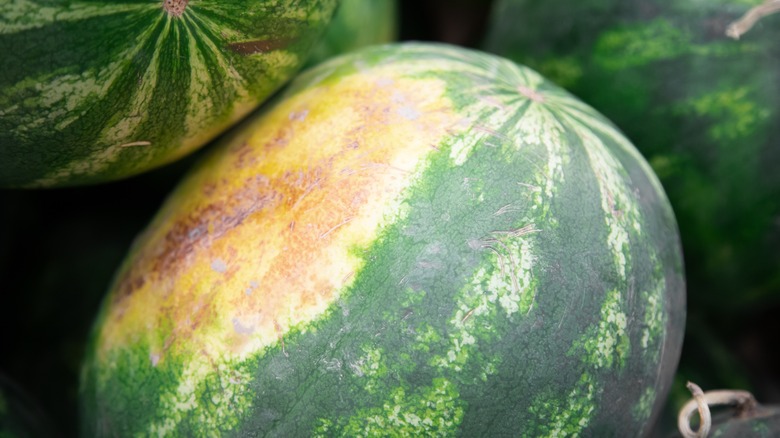How To Identify The Best Watermelon By The Field Spot
Our food shopping experience today is pretty far removed from the actual field where produce and grains are grown and harvested — but learning just a little bit about the agricultural process will make it much easier for you to select fruit that's most likely to be perfectly ripe and sweet. Your first lesson? The ever-so-refreshing watermelon.
There are a few methods you can use to pick out the tastiest watermelon at the store, which is typically in season from May through September depending on the climate of the state that it's grown in. These include making sure there are no signs of spoilage and choosing a heavy melon to ensure a satisfyingly juicy interior. But the best way to guarantee ripeness is by looking for a field spot on the melon; a field spot is the side of the melon that was resting on the ground while it was growing on the vine. If your produce of choice was left on the vine long enough to ripen, the field spot will be dark yellow or orange. If not, it will more likely be white.
Signs of a good watermelon
We've all bitten into a bad slice of watermelon at a summer barbecue: too thick of a rind and a mouthful of mushy, mealy fruit. This mealiness is what happens when a watermelon is overripe, loses moisture, and becomes dry and almost grainy. But if you follow the field spot hack to pick out the perfect watermelon, you're in for something totally different. A truly good watermelon should be super juicy and sweet, and even though the fruit contains about 92% water, biting into one should be crunchy, not soft. A watermelon's rind should not be too thick either, as a thinner rind indicates that you have a higher amount of fruit flesh per melon.
Once you've picked your perfect melon, the options are endless; from a summer salad to an agua fresca, there are a million recipes calling your name. And don't throw away the rinds — instead, ring in a zero waste era by testing out this 3-step watermelon rind candy recipe.

